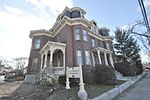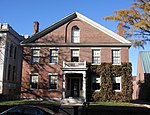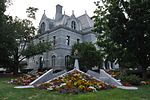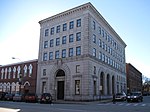Reuben Foster House and Perley Cleaves House
Greek Revival houses in New HampshireHistoric house museums in New HampshireHouses completed in 1848Houses in Concord, New HampshireHouses on the National Register of Historic Places in New Hampshire ... and 1 more
National Register of Historic Places in Concord, New Hampshire

The Reuben Foster House and Perley Cleaves House are a pair of nearly identical Greek Revival houses at 64 and 62 North State Street in Concord, New Hampshire. Built 1848–1850, they are among New Hampshire's best examples of Greek Revival architecture, having undergone only relatively modest alterations. The houses were listed on the National Register of Historic Places in 1982. The Cleaves House is further notable for its association with Mary Baker Eddy, and now serves as a historic house museum.
Excerpt from the Wikipedia article Reuben Foster House and Perley Cleaves House (License: CC BY-SA 3.0, Authors, Images).Reuben Foster House and Perley Cleaves House
North State Street, Concord
Geographical coordinates (GPS) Address Nearby Places Show on map
Geographical coordinates (GPS)
| Latitude | Longitude |
|---|---|
| N 43.209722222222 ° | E -71.540833333333 ° |
Address
North State Street
03301 Concord
New Hampshire, United States
Open on Google Maps










